This story began thousands of years ago, about 5000 years ago. When Mayan Civilization was nowhere in existence, Inca Empire was not yet born, Stonehenge were yet to built and Europe was in its primitive stage, there was a civilization in Egypt, creating a proud testament of human endeavor that was going to enthrall the generations for the centuries at different geographical locations. The Pyramids of Egypt are not a mere huge stone structures built by The Pharaohs, they are the most recognizable, most mysterious and most enduring structures of the world, standing tall from nearly 5000 years in the midst of the river flood, mighty sandstorms and major earthquakes.
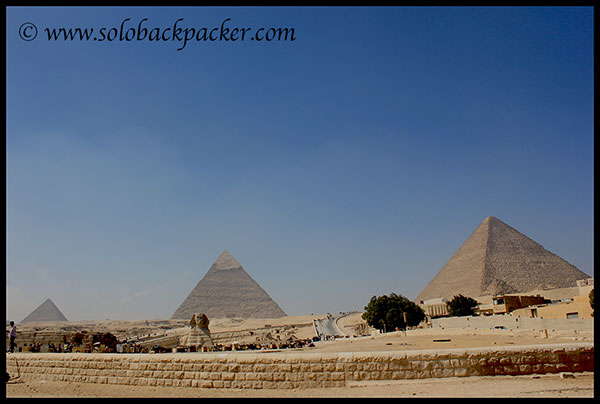
The first ever pyramid, The Step Pyramid, was built in Sakkara, nearly 20 kms away from the Pyramid Complex of Giza, but it is the Great Pyramid of Khufu at Giza, which gave them an immense popularity and sheer grandeur.
I was landed in Egypt a night before on a backpacking trip and on the first day itself, I just wanted to visit the Pyramid Complex of Giza. Good thing about the Pyramid Complex is its location. They are located very close to the city of Cairo and easily accessible. There are various ways to reach the Pyramid Complex from the heart of Cairo, Downtown Area. You can find a detailed description in this post: How to Reach Giza Pyramids from Cairo Downtown?
Using Cairo Metro and then a public bus, I reached at the pyramid complex about 8.30 AM. First sight of the complex was a big disappointment for me. Whole area was covered by the dense fog and those grand pyramids were not visible at all. There was an excitement, there was an eagerness, there was a joy, but there was bad weather also to spoil the party. I could only pray for a clear weather. After avoiding many vendors, tourist touts and package sellers, I reached to the ticket counter of Pyramid Complex near the main entrance.
The Pyramid Complex of Giza: After buying three tickets (one entry ticket to pyramid complex (LE 60), one ticket to enter inside the great pyramid of Giza (LE 100) and another one for my camera tripod (LE 20)); I entered through the main entrance towards the Great Pyramid and then it was a flood of tourist guides and vendors. It was my first day in Egypt, so I also got trapped in some vendors’ tricks, that I will explain later in a separate post.
Update, Jan. 2019: Due to the devaluation of Egyptian Currency, prices for above-mentioned tickets have gone up. New prices are like Entry to the Pyramid Complex ( 160 LE), Entry inside the Great Pyramid ( 360 LE), Entry inside 2nd or 3rd Pyramid (100 LE), Entry to Solar Boat Museum (100 LE) etc.
I reached at the base of the Great Pyramid and the weather was still not good. I didn’t count to how many people I asked about the predicted time of clear weather. I was so desperate, disappointed , and excited also.
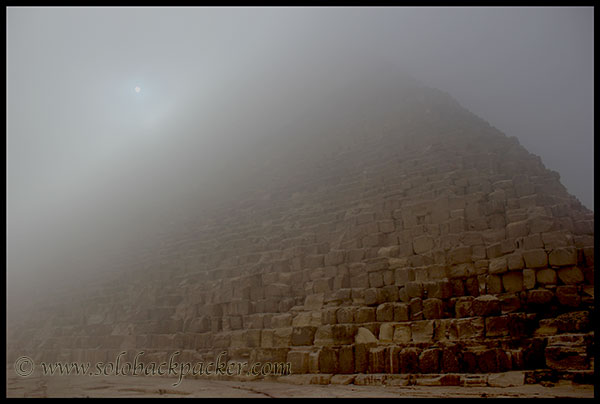
Inside The Great Pyramid of Khufu: The Great Pyramid is also known as The Pyramid of Khufu or The Pyramid of Cheops and built during 2560–2540 BC.
Since the weather was foggy, I decided to visit the interior of the Great Pyramid first. Cameras are not allowed inside the pyramid, but you can take your mobile phones and bags with you. The guard at the entry gate insisted me to keep my camera there, so I kept it there.There is no lockers, but he gave me a number slip, and kept the another number slip there with my camera to match it with my slip while returning that back.
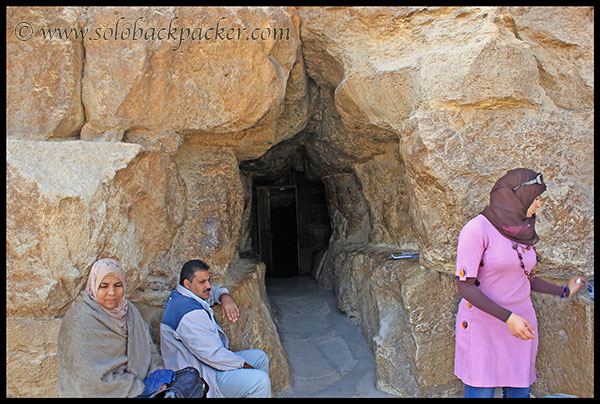
The main entrance of the great pyramid is now close. The present entrance, known as Robber’s Entrance is now used for the entry, which is at lower level than the ancient main entrance. Inside the pyramid, there are many structures like King’s Chamber, Queen’s Chamber, Mortuary Temple, Causeways, Grand Gallery etc. But, entry is only allowed to the King’s Burial Chamber through the grand gallery. There are many ascending and descending passages before you reach to the King’s Chamber.These passages are about 3-feet wide and to avoid the slippery surface, there are thick iron bars fitted on the wooden surface. Sometimes, you have to even bend yourself on the knees to move further.
These passages or galleries lead to a rectangular room known as King’s Chamber. The room is empty and except a granite sarcophagus, nothing else is there. This room was the tomb of the Pharaoh Khufu, where his mummified body was kept in a sarcophagus along-with the jeweleries, ornaments and other items, that the Pharaoh might required in the afterlife. The granite slab of the chamber’s wall is connected so precisely that even after so many years you will not find a gap to put a razor blade inside.
It was very hot inside the pyramid compared to the outside foggy weather. After spending few minutes, I came outside from the hot chamber. I really wanted to click a picture of that tunnel passage going inside the pyramid with my cell camera. Then, I realized that I have another digital camera in my bag. I knew it was against the rule and ethics, but there was a strong desire. So, I took it out and clicked this picture of the passage leading to the chamber. But be aware there are CCTV cameras mounted on the walls. I did not click another picture and came outside.
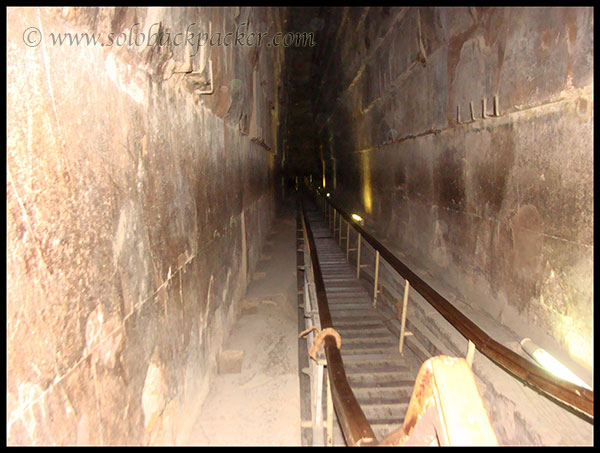
Outside The Great Pyramid of Khufu: When I reached outside, the weather was clearing by then and within 30 minutes, it became a perfect day to click the massive size of the pyramids. The pyramids are huge in size, vast in expanse and magnificent in appearance. A stock of stone blocks one over another and side by side connected so precisely and so firmly that from last 4000 years they are still standing tall, challenging the nature forces in the middle of a desert. They were the result of highly skilled techniques and their logistics method is still a mystery to the modern-day architectures.
The Great Pyramid originally stood 146 meters high and was 230 meters on each side at the base. Nowadays its height reduces to 137 meters. It covers an area of 13.1 acres and is estimated to contain 2,300,000 blocks on stone, each of which weigh about 1.5 tons on average, and the granite blocks used to roof the burial chambers are estimated to weigh up to 80 tons each. The Great Pyramid is built of limestone, quarried locally. The fine limestone for the casing was brought from the quarries on the eastern bank of the Nile, near to the modern city of Cairo, and the granite used in the interior of the monument came from Aswan, nearly 800 kms away. Even today with modern-age machines and cranes, carrying such a huge stone block is a very difficult task.
After their original construction the whole pyramid was surfaced by blocks of highly polished white limestone. During the course of so many years, those casing stones were eroded and in a major earthquake in 1300 AD, the most of those casing stones were loosened. Later, many of them were carted away by Bahri Sultan to built many mosque and fortresses in nearby Cairo.
Another interesting thing of the Great Pyramid is its top. The top of the Great Pyramid is not conic as other one, but it looks flat. In fact, it is almost 30-feet flat on the top. Climb on the top is strictly prohibited now, but it was not the case always. You can see three iron rods resembling like an antenna. These iron rods were placed by two astronomers in 1874 to show where the Pyramid’s actual apex would have been if finished.
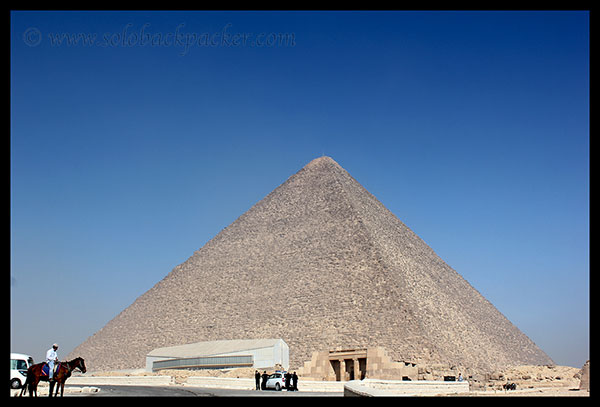
The Pyramid of Khafre: Built in around 2520 B.C., this is the second largest and second tallest pyramid after the Great Pyramid of Giza. It was built as a tomb of Pharaoh Khafre (Chefren), the son of Pharaoh Khufu, hence also known as the Pyramid of Chefren. The pyramid has a base length of 215.5 meter and rises to a height of 136.4 meters, which was originally 143.5 meter. The Pyramid is made of limestone blocks , many of them weighing more than 2 tons each. Unlike the Great Pyramid of Khufu, its outer casing of white polished limestone is still intact at the topmost part and these are the only remaining casing stones on a Giza Pyramid. The architectural components of Khafre’s complex with its pyramid, upper temple, causeway and lower temple give us our most complete understanding of an Old Kingdom funerary complex.
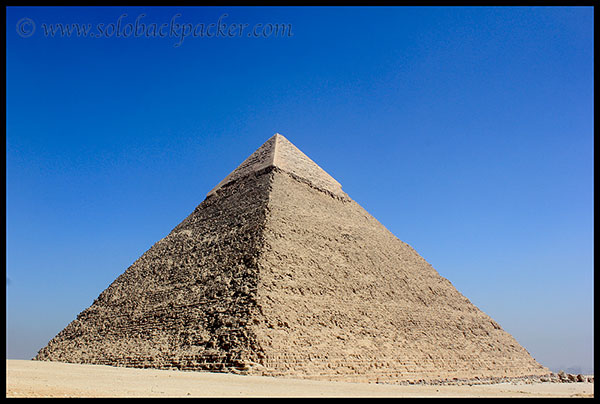
The Pyramid of Menkaure: Built in around 2490 B.C.,Menkaure’s Pyramid had an original height of 65.5 meters and was the smallest of the three major pyramids at Giza. It now stands at 61 meter tall with a base of 108.5 meters. It was constructed of limestone and granite. Pharaoh Menkaure died before the completion of this pyramid and thus his son finished rest of the construction.
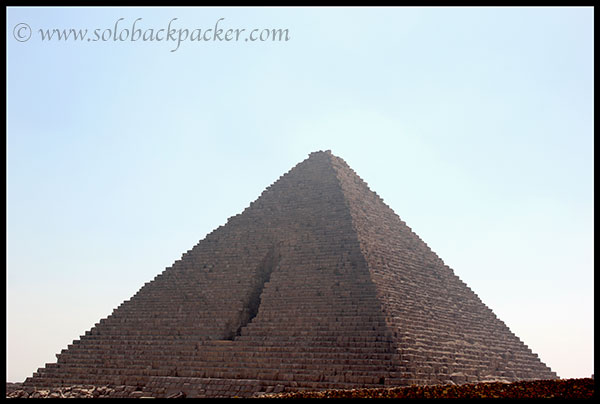
The Queen’s Pyramids: There are three smaller pyramids lying side by side near the pyramid of Menkaure. These pyramids belong to the Pharaoh’s wives and they do not have much importance in Ancient Egypt. They look like a mound of stones and there interior is not so impressive, even some of the interior architectures are incomplete.
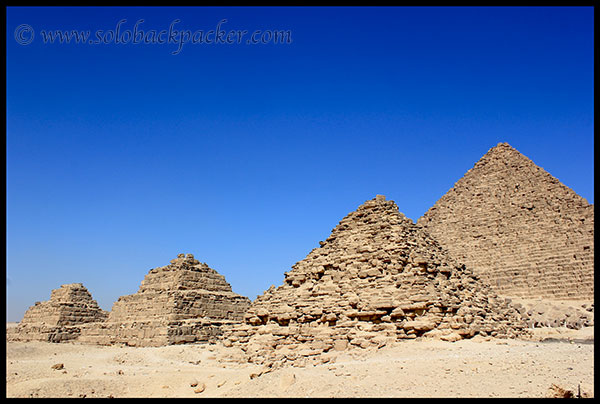
The Great Sphinx at Giza: This 73 meters long and 5 meters high statue is one of the most important statue in the Ancient History. The Sphinx is a composite of a lion’s body with a king’s face and head that symbolically wear the nemes headdress and a false beard. The beard, now lost, must have been sculpted with the head because it would be impossible to add it as a separate piece. During excavations, a small portion of the beard found in two parts. One of this part is now in the British Museum and second is in the Egyptian Museum. Nose of the Sphinx statue is also missing. That might be sculpted away during the later period. There is a causeway connecting the Great Sphinx of Giza to the causeway of The Pyramid of Khafre, so people believe that it might had been constructed by The Pharaoh Khafre. The history of Sphinx is still not revealed and it is considered as the most mysterious structure in the pyramid complex of Giza.
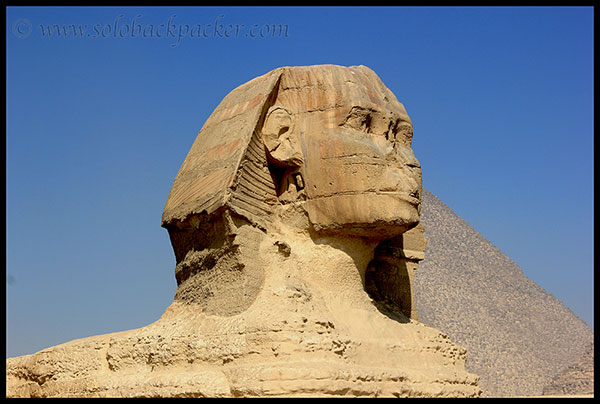
While I was walking near the Sphinx, a local visitor requested me to take a picture of her daughter. I clicked these cuties near the Sphinx.
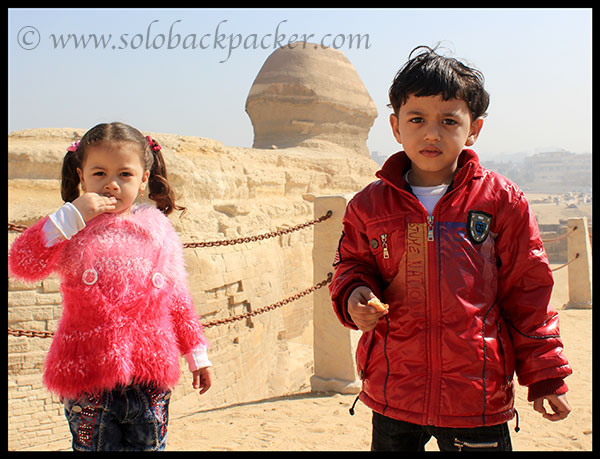
Entry to the base of The Sphinx are not allowed to everyone. However, I found some local people near the base of the statue who were offering some kind of prayer there.
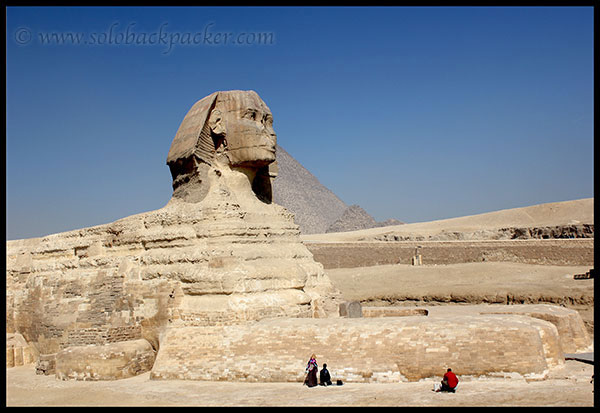
The most important thing to remember there is that climbing on the pyramid is strictly prohibited. The area of the Giza complex is very vast and you may be able to dodge the security, but if caught, you will be in a big trouble. Anyway, the pyramid stone blocks are not safe for climb at all. This picture shows how risky it is to climb on the pyramids now.
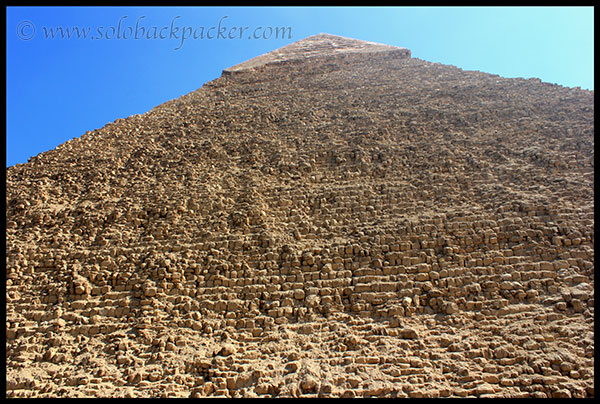
The pyramids in the Giza complex are living from many years with a kind of paradoxes. They are so ancient, so familiar to the world, but they are very mysterious and yet so little was accurately known about them. This unknown side of their mystery is fascinating the world’s travelers and researchers from the centuries. Living a day near the mysterious but everlasting world of the pyramids was like a dream come true. I indeed lived my dream that day at The Pyramid Complex of Giza.
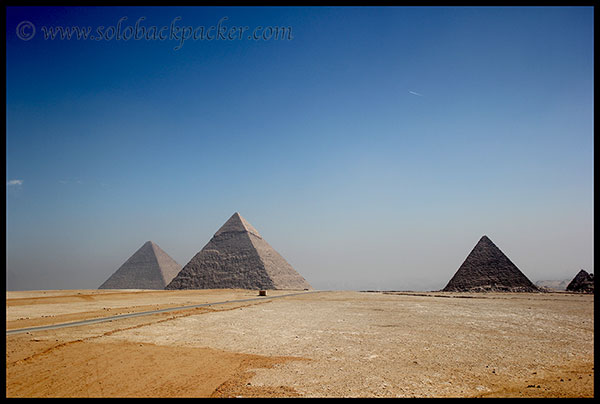
I


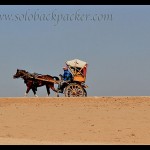
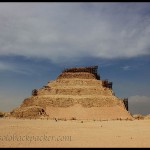
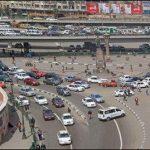

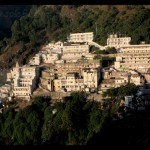
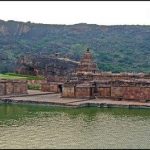
Sir I want to know about Train or Air service from Aswan/Luxor to Alexandria. If possible give details timing (Government train service is preferable because of economical)
Thanks
Soumitra
Calcutta
Most of the economical flights between Aswan/Luxor to Alexandria route via Cairo. Similarly, to reach there by a train, you have to first reach Cairo from Aswan/Luxor and then by another train from Cairo to Alexandria.
Most useful and helpful blog I have ever seen. We are traveling to Egypt in April. Not sure if this is ideal and good time to visit the place. Can you please share how did you travel from Pyramid of Giza to Dahashur and other pyramids. Do you recommend a day tour package? if not, are there public vehicles to take us from every place? Thanks!
Hi, I hired a cab to travel from Giza to Dahsur, Saqqara and Memphis. These are the remote areas and public transport is not viable. Only few options available, but at the end, you have to walk for miles to reach at these pyramids after leaving the public transport. Better to hire a cab. 🙂
Thank you. I am little confused whether to book a tour or travel on self.
Can we travel around egypt(cairo, Luxor, aswan, hurghada) on our own, by taking day tours where ever applicable? Or is it difficult to plan these places.
Hi, You can travel around on your own. No need to book a tour. If you wish to use public transport, the buses are available for every place and they are perfectly safe. Else, you always have an option to hire a taxi.
Elles sont vraiment magnifiques les pyramides , ça m’étonne comment les gens du passé on pu construire de telles merveilles.
Thanks God…Google Translate is here. 🙂
Back to your comment:
“They are truly magnificent pyramids, it amazes me how people in the past we have built such wonders.”
This is what incredible about the pyramids..They attract and amaze the whole world.